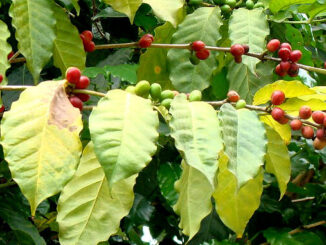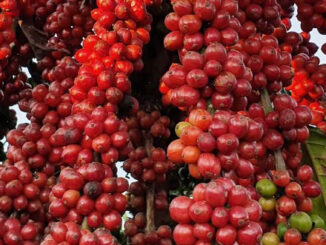
The Liberica coffee species (Coffea liberica) is one of the most distinctive and underappreciated members of the coffee family.
Known for its large beans, floral aroma, and complex flavor, Liberica has produced several natural sub-varieties and hybrids that are valued for their resilience and unique taste.
Though it represents only a small percentage of global coffee production, Liberica and its derivatives are crucial for biodiversity and climate-resistant farming.
🌿 Overview of Liberica Coffee
Coffea liberica originated in West and Central Africa, particularly Liberia, Uganda, and Angola.
It was introduced to Southeast Asia in the 19th century after the Arabica coffee rust epidemic, where it quickly adapted to tropical conditions.
The Liberica plant differs from other species in both appearance and character:
- Tall trees that can grow up to 15 meters
- Large, leathery leaves
- Oval-shaped cherries
- Big, asymmetrical beans with a hook-like tip
- Deep root systems that improve drought resistance
Liberica thrives in lowland tropical areas (200–800 m altitude) and humid climates, making it ideal for regions where Arabica struggles.
☕ Flavor Profile of Liberica Coffee
Liberica coffee is famous for its distinctive and bold flavor that sets it apart from Arabica and Robusta.
Typical tasting notes:
- Floral and fruity aroma
- Full, heavy body
- Low to medium acidity
- Woody and smoky undertones
- Hints of jackfruit, dark chocolate, and spice
This complex and exotic profile makes Liberica a favorite among coffee enthusiasts looking for something unusual and intense.
🌱 Major Varieties and Hybrids Derived from Liberica Coffee
Over time, both natural and cultivated varieties of Coffea liberica have evolved in different parts of the world.
Below are the most notable derived varieties and hybrids associated with Liberica.
1. Liberica var. Dewevrei (Excelsa Coffee)
- Discovered in Central Africa, this is the most recognized sub-variety of Liberica.
- Scientifically known as Coffea liberica var. dewevrei.
- Features smaller trees and beans than typical Liberica.
- Flavor profile: fruity, tart, and complex, with hints of spice and tamarind.
- Highly valued for its genetic diversity and hardiness, used in breeding programs and hybrid development.
2. Liberica var. Dewevrei Barako (Philippine Barako Coffee)
- A heritage variety native to Batangas and Cavite in the Philippines.
- Known locally as Kapeng Barako.
- Derived from the Liberica dewevrei group but with larger beans and a stronger aroma.
- Flavor profile: bold, woody, slightly floral, with hints of anise and dark chocolate.
- Represents cultural pride and tradition in Filipino coffee history.
3. Liberica–Robusta Hybrids
- Crosses between Coffea liberica and Coffea canephora (Robusta).
- Developed to combine Liberica’s resilience with Robusta’s high yield.
- Common in West Africa, Indonesia, and the Philippines.
- Flavor: strong, earthy, full-bodied, with mild fruitiness.
- Offers high adaptability to heat, humidity, and low-altitude environments.
4. Excelsa–Arabica Experimental Hybrids
- Created by researchers to merge Excelsa’s hardiness and Arabica’s quality flavor.
- Still largely experimental due to genetic differences.
- Show promise for climate-resilient coffee breeding.
- Early test results indicate moderate acidity, floral aroma, and medium body.
5. Local African Strains (Wild Liberica Populations)
- Found in Uganda, Congo, Cameroon, and Sierra Leone.
- These wild populations are vital for preserving genetic diversity.
- Often used as rootstock for grafting or crossbreeding with Arabica and Robusta.
- Known for excellent root strength and natural pest resistance.
6. Southeast Asian Liberica (Malaysia, Indonesia, Vietnam)
- These regional strains evolved from the original African stock.
- In Malaysia, Liberica has become a distinct coffee identity — floral, caramel-like, and rich.
- In Vietnam, it’s used in blends for added sweetness and aroma.
- In Indonesia, small Liberica farms produce coffees with tropical fruit and woody notes.
🌾 Agricultural Advantages of Liberica-Derived Varieties
✅ High tolerance to heat, humidity, and variable rainfall
✅ Deep root system that resists drought
✅ Natural resistance to several pests and fungal diseases
✅ Distinctive flavor for specialty coffee markets
✅ Genetic diversity for future hybridization and research
These traits make Liberica and its descendants vital for climate-smart agriculture and sustainable coffee cultivation.
⚠️ Challenges of Liberica Coffee Varieties
❌ Tall trees make harvesting difficult and labor-intensive
❌ Lower yield compared to Arabica and Robusta
❌ Irregular fruiting cycles in some regions
❌ Limited global demand due to its strong, unusual flavor
❌ Processing difficulties — thicker cherry pulp requires more time and water
Despite these challenges, the renewed interest in unique coffee experiences and climate-resilient crops has brought Liberica back into focus for both farmers and coffee connoisseurs.
🌍 Role of Liberica in the Future of Coffee
As climate change continues to threaten global coffee production, Liberica’s traits — heat tolerance, deep roots, and genetic variability — are becoming increasingly important.
Scientists are studying Liberica and its derivatives for:
- Breeding disease-resistant hybrids
- Developing lowland coffee systems
- Preserving biodiversity in coffee plantations
- Enhancing flavor diversity in specialty markets
Liberica could play a crucial role in ensuring the long-term sustainability of the coffee industry.
❤️ Final Thoughts
The Liberica coffee species is more than a rarity — it’s a key to the future of coffee cultivation.
Its derived varieties, such as Excelsa, Barako, and Liberica–Robusta hybrids, show how genetic diversity can shape both flavor and resilience.
While still niche, these varieties represent the bold, adaptive spirit of coffee — strong, complex, and capable of thriving where others cannot.
☕ Liberica coffee: the giant tree with a giant legacy.
DeliciousPath: Enjoyment in Every Moment
Explore the Gourmet on Board category for exquisite flavors that elevate your meals, even when you’re on a boat, and the Coffee category for aromatic coffee blends that make every moment special. DeliciousPath is here to turn every experience into something unforgettable!
























